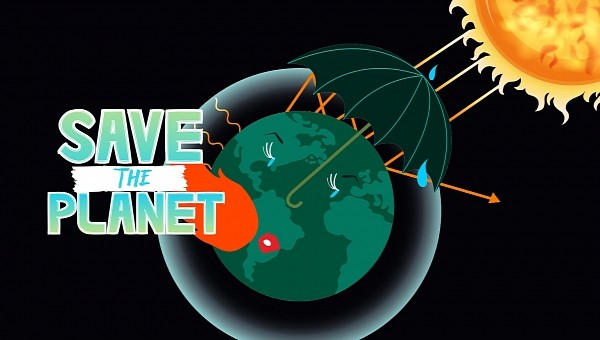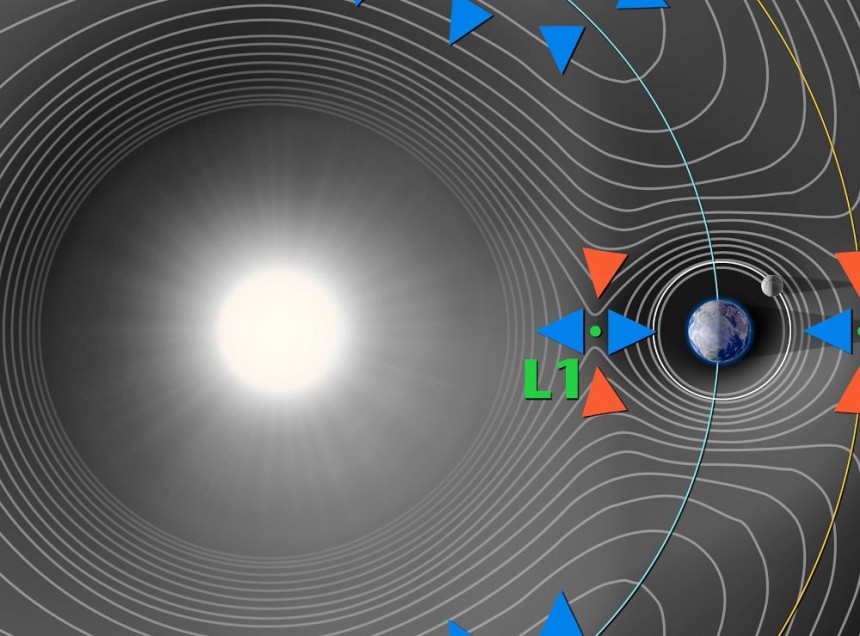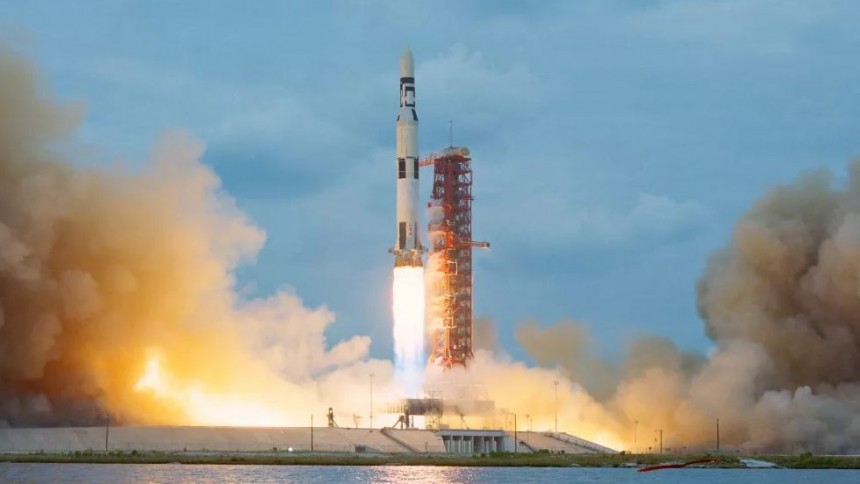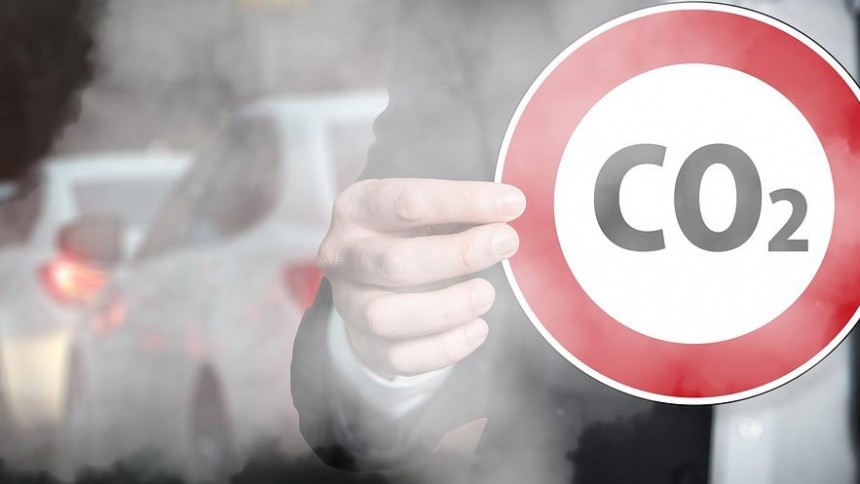Global warming, for the nerds, states that CO2 is trapping heat in the atmosphere, and Earth’s temperature is rising to unsustainable levels. If you disagree with the overwhelming majority of scientists regarding humanity's duty, you might think it's brilliant to block sunlight from space.
Humans are going back to space thanks to Elon Musk, Jeff Bezos, and Richard Branson. Oh, and NASA, of course, along with other national space agencies out there. Hey, Elon, where is that Tesla Roadster? Is it still floating in space, or was it involved in an accident with an asteroid?
If so, the car was probably turned into a thousand pieces, a cloud of metal and plastic chips floating around. You know, if that cloud is getting to a Lagrange point, it will stick there forever. Because at this point, the gravitational forces of the Sun and Earth “produce enhanced regions of attraction and repulsion,” as NASA explains.
So now you have this tiny cloud of Tesla’s remains between the Sun and Earth. You should know that it has a tiny influence on the heat amount that gets to Earth. Now imagine all the Tesla cars in the world shredded into pieces and floating in that Lagrange point. They could trap some of the heat the Sun is sending toward Earth.
I know; it sounds hilarious. I’m sure the Tesla Roadster is still out there in space, so this story is entirely nonsense. But is it? It seems the idea of a cloud of dust in a Lagrange point just popped up in a research article published by a team of mad scientists from the University of Utah.
The title is almost self-explanatory: “Dust as a solar shield.” Basically, what the astrophysicists are saying is. Theoretically, we could use an amount of dust in space “to achieve sunlight attenuation of 1.8%, equivalent to about 6 days per year of an obscured Sun.”
It could be, in theory, a possible climate change mitigation measure, according to researchers. Climate-impacting reduction in solar radiance on Earth requires a large cloud of dust. Because, you know, every second, the Sun is sending to Earth around 3.8 x 10^23 kW of power, which translates into heat trapped by the evil CO2.
Researchers did the math, and they drew some conclusions, as follows. First of all, we need to send to L1 Lagrange point – which lies 1.5 million km (almost 1 million miles) from the Earth towards the Sun –roughly 10 million tons of dust every year.
Which is approximately 700 times more mass than humans have launched into space so far. Or, better, almost 5% of the weight of all 8 billion people on the planet. So, every year we would have to launch 20,000 Saturn V rockets into space – that is one rocket every half an hour. Humanity sent to space less than 400 rockets until now.
But there’s another option. How about mining this amount of dust from the Moon and sending the particles on ballistic trajectories to L1 Lagrange points? The energy required equals 2,500 Saturn V launches, and it could be feasible to source it from an area of around 10 square km (6.2 square miles) on the Moon.
Let's not forget that this process is needed every year because the persistence of dust clouds can be short. Given that weight of the Moon is estimated at approximately 8.1 x 10^19 tons, there's plenty of material for a few millennia until damaging the Earth's natural satellite to the point of no return.
But, hey, we could use asteroids to shield the Earth. Because, you know, all those billionaires want to go into space for mining purposes. In the meantime, we could use fossil fuels instead of renewables. For instance, coal reserves are good for another 400 years from now, while natural gas is enough for another 150 years or so.
Of course, such a research article is based only on cold numbers. It doesn’t consider any impact on biodiversity. Every time a big volcano eruption occurred, the influence of the aerosols in the atmosphere led to a slight decrease in global temperature.
But it also affected crops, animals' behavior, and the activity of humans. Besides, climate researchers observed all kinds of anomalies in atmosphere processes. The general conclusion is blocking the Sun has a negative impact on life on this planet.
The bottom line is this study has a practical value close to zero. Even if the majority of the scientific community would agree on the idea of a slight shielding of Earth from Sun's energy, humanity is not able to put into practice such a project.
The Earth's atmosphere is warming at a fast pace, and we simply don't have time to create the technologies needed for this project's purposes. We can only hope that, by transitioning as fast as we can from a fossil fuel-based society to a renewable one, we can avoid a catastrophic scenario.
But that requires the skeptics to give up their beliefs that burning huge amounts of fossil fuels has nothing to do with global warming. Or that it doesn't influence climate change. It all comes down to logic and understanding the information correctly. This way, it's easy to understand the wackiness of continuing to use fossil fuels and that shielding Earth is futile.
If so, the car was probably turned into a thousand pieces, a cloud of metal and plastic chips floating around. You know, if that cloud is getting to a Lagrange point, it will stick there forever. Because at this point, the gravitational forces of the Sun and Earth “produce enhanced regions of attraction and repulsion,” as NASA explains.
So now you have this tiny cloud of Tesla’s remains between the Sun and Earth. You should know that it has a tiny influence on the heat amount that gets to Earth. Now imagine all the Tesla cars in the world shredded into pieces and floating in that Lagrange point. They could trap some of the heat the Sun is sending toward Earth.
I know; it sounds hilarious. I’m sure the Tesla Roadster is still out there in space, so this story is entirely nonsense. But is it? It seems the idea of a cloud of dust in a Lagrange point just popped up in a research article published by a team of mad scientists from the University of Utah.
It could be, in theory, a possible climate change mitigation measure, according to researchers. Climate-impacting reduction in solar radiance on Earth requires a large cloud of dust. Because, you know, every second, the Sun is sending to Earth around 3.8 x 10^23 kW of power, which translates into heat trapped by the evil CO2.
Researchers did the math, and they drew some conclusions, as follows. First of all, we need to send to L1 Lagrange point – which lies 1.5 million km (almost 1 million miles) from the Earth towards the Sun –roughly 10 million tons of dust every year.
Which is approximately 700 times more mass than humans have launched into space so far. Or, better, almost 5% of the weight of all 8 billion people on the planet. So, every year we would have to launch 20,000 Saturn V rockets into space – that is one rocket every half an hour. Humanity sent to space less than 400 rockets until now.
But there’s another option. How about mining this amount of dust from the Moon and sending the particles on ballistic trajectories to L1 Lagrange points? The energy required equals 2,500 Saturn V launches, and it could be feasible to source it from an area of around 10 square km (6.2 square miles) on the Moon.
Let's not forget that this process is needed every year because the persistence of dust clouds can be short. Given that weight of the Moon is estimated at approximately 8.1 x 10^19 tons, there's plenty of material for a few millennia until damaging the Earth's natural satellite to the point of no return.
Of course, such a research article is based only on cold numbers. It doesn’t consider any impact on biodiversity. Every time a big volcano eruption occurred, the influence of the aerosols in the atmosphere led to a slight decrease in global temperature.
But it also affected crops, animals' behavior, and the activity of humans. Besides, climate researchers observed all kinds of anomalies in atmosphere processes. The general conclusion is blocking the Sun has a negative impact on life on this planet.
The bottom line is this study has a practical value close to zero. Even if the majority of the scientific community would agree on the idea of a slight shielding of Earth from Sun's energy, humanity is not able to put into practice such a project.
The Earth's atmosphere is warming at a fast pace, and we simply don't have time to create the technologies needed for this project's purposes. We can only hope that, by transitioning as fast as we can from a fossil fuel-based society to a renewable one, we can avoid a catastrophic scenario.









